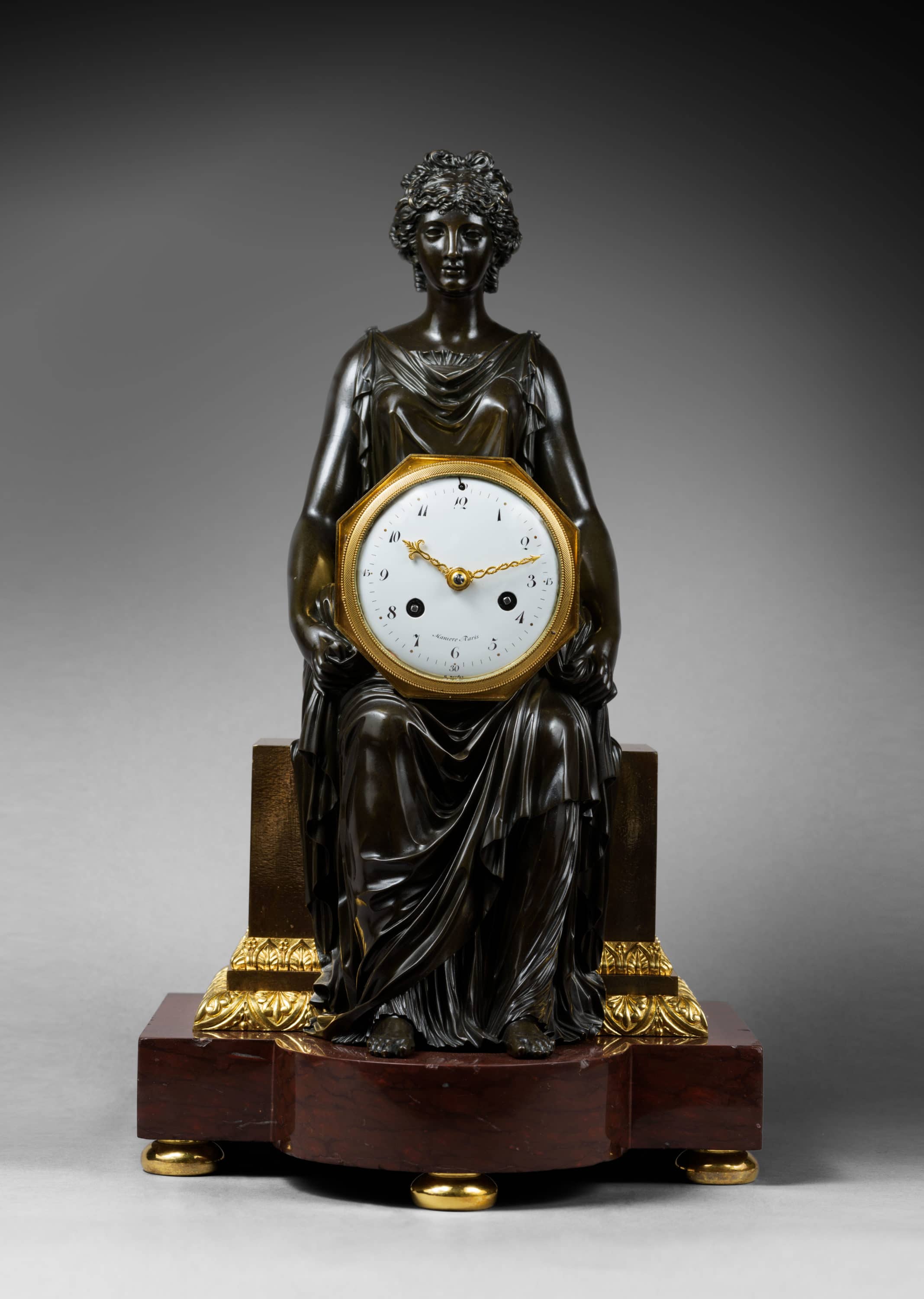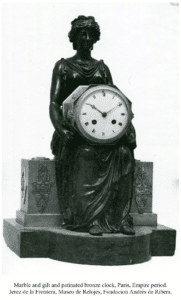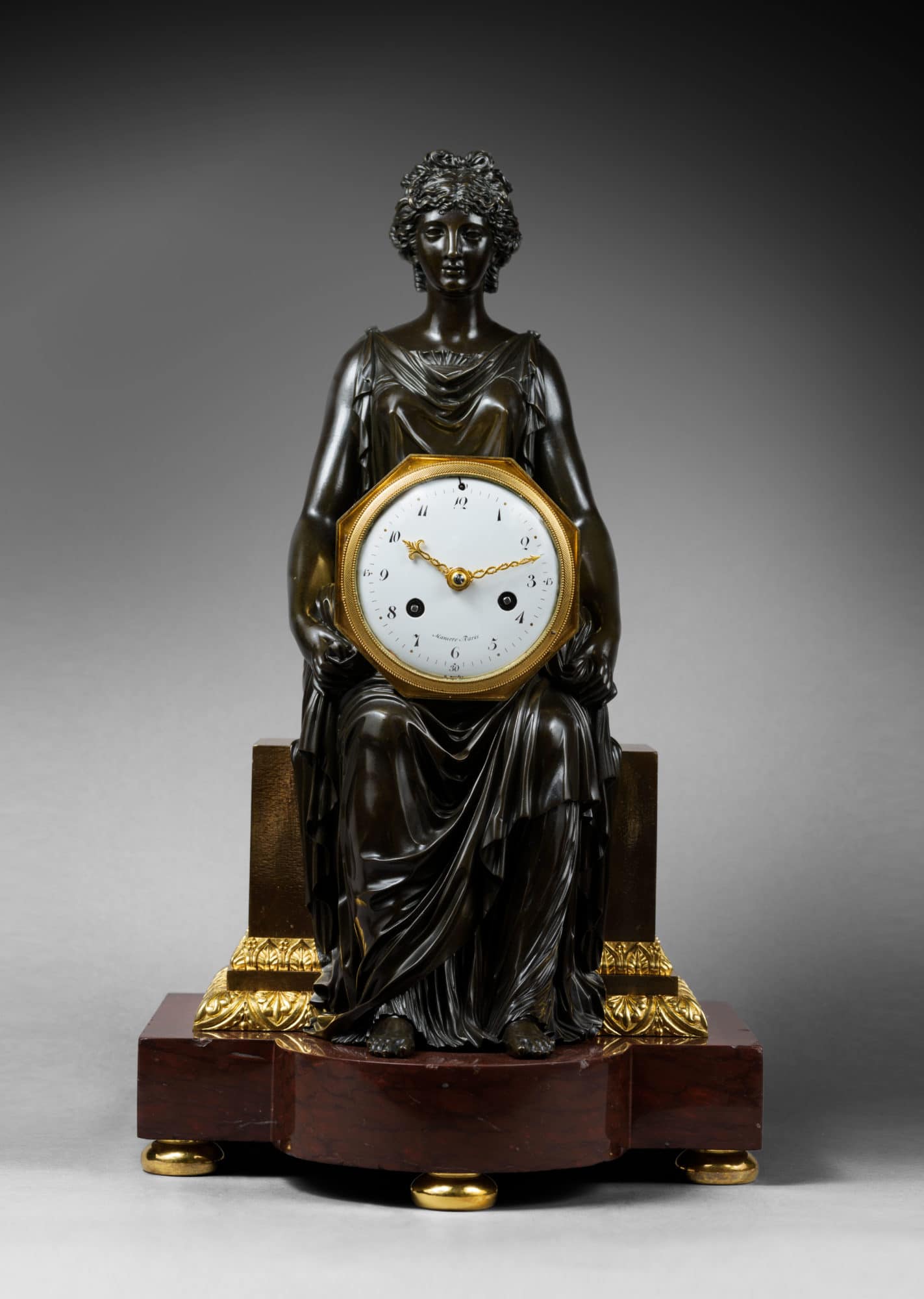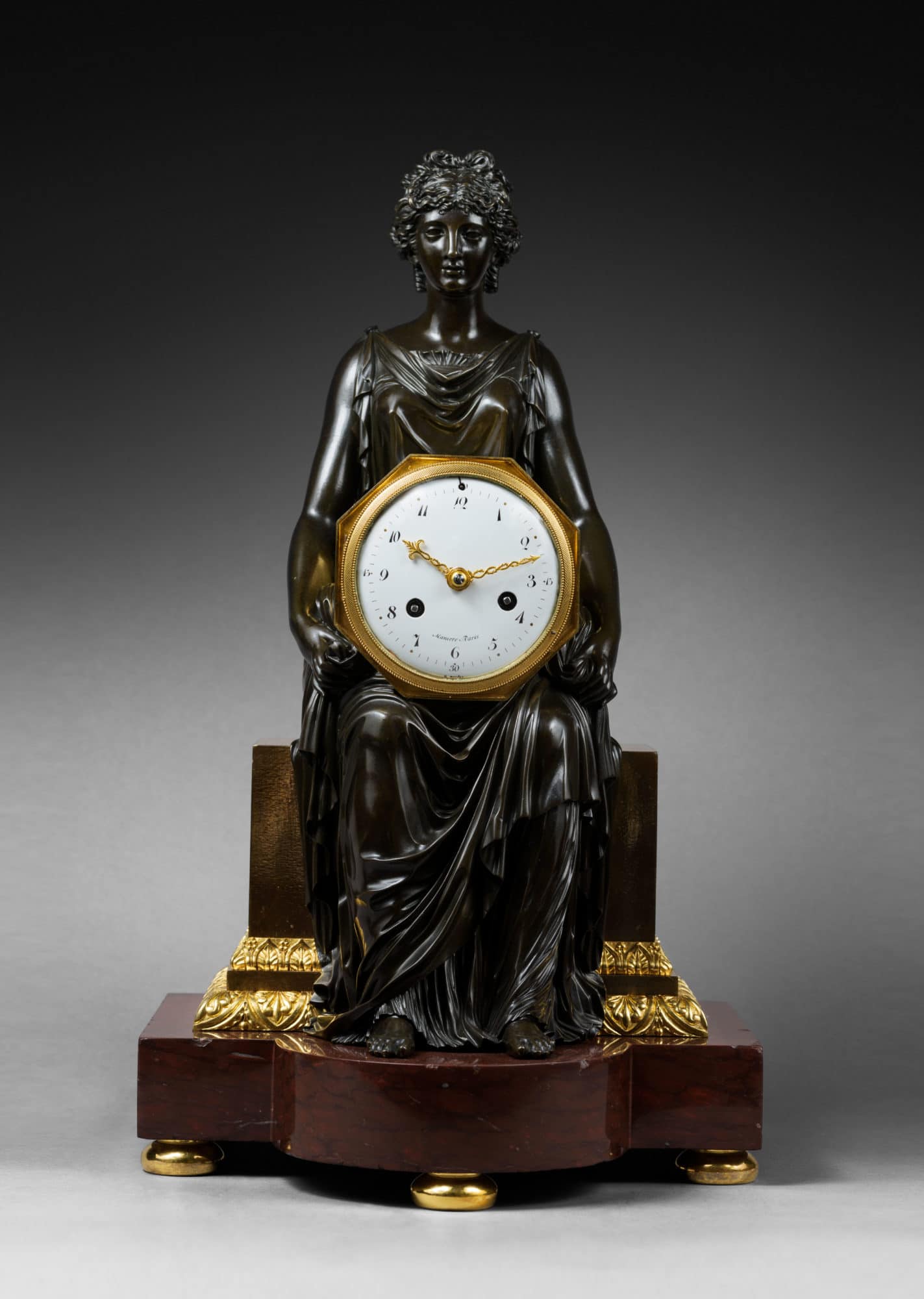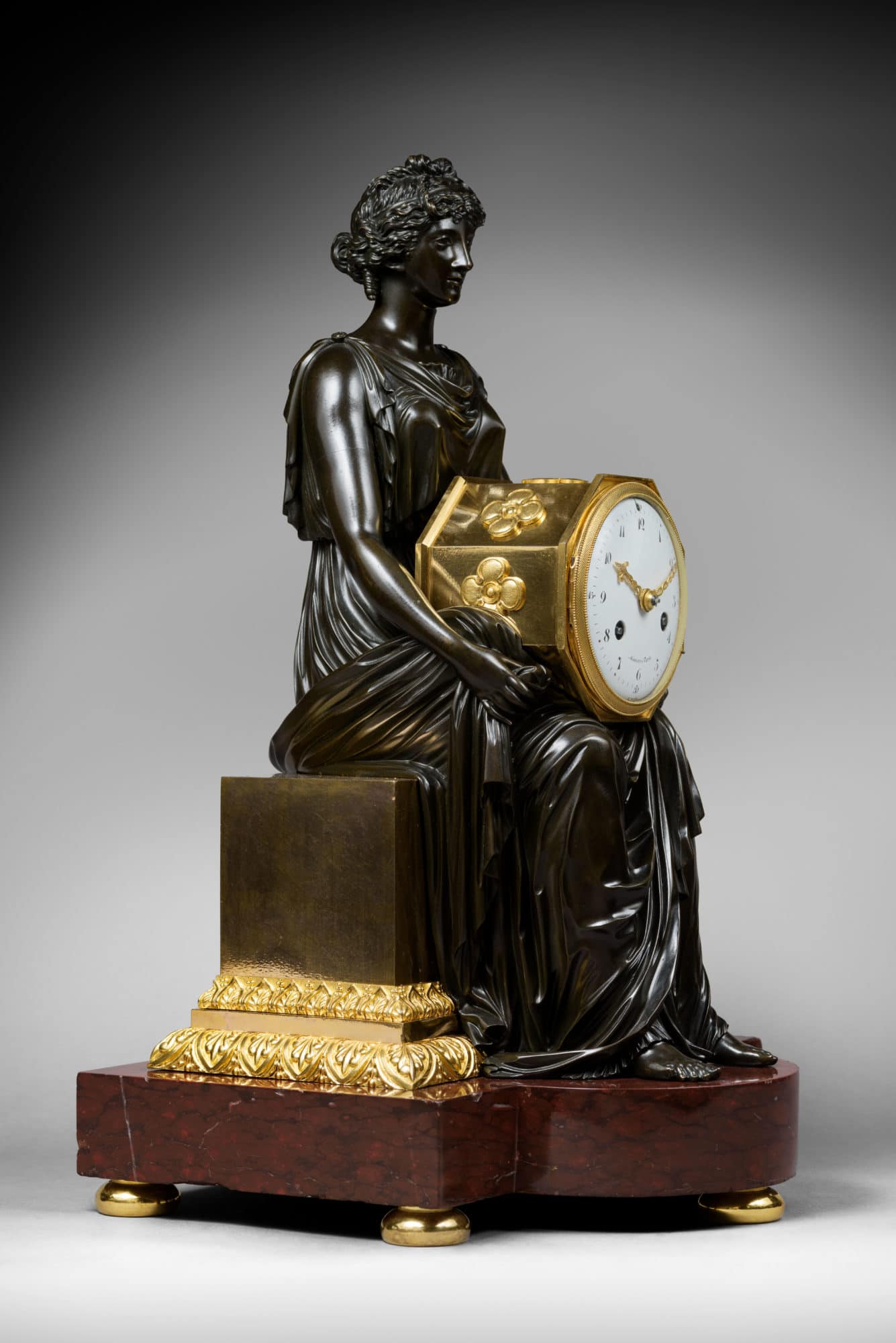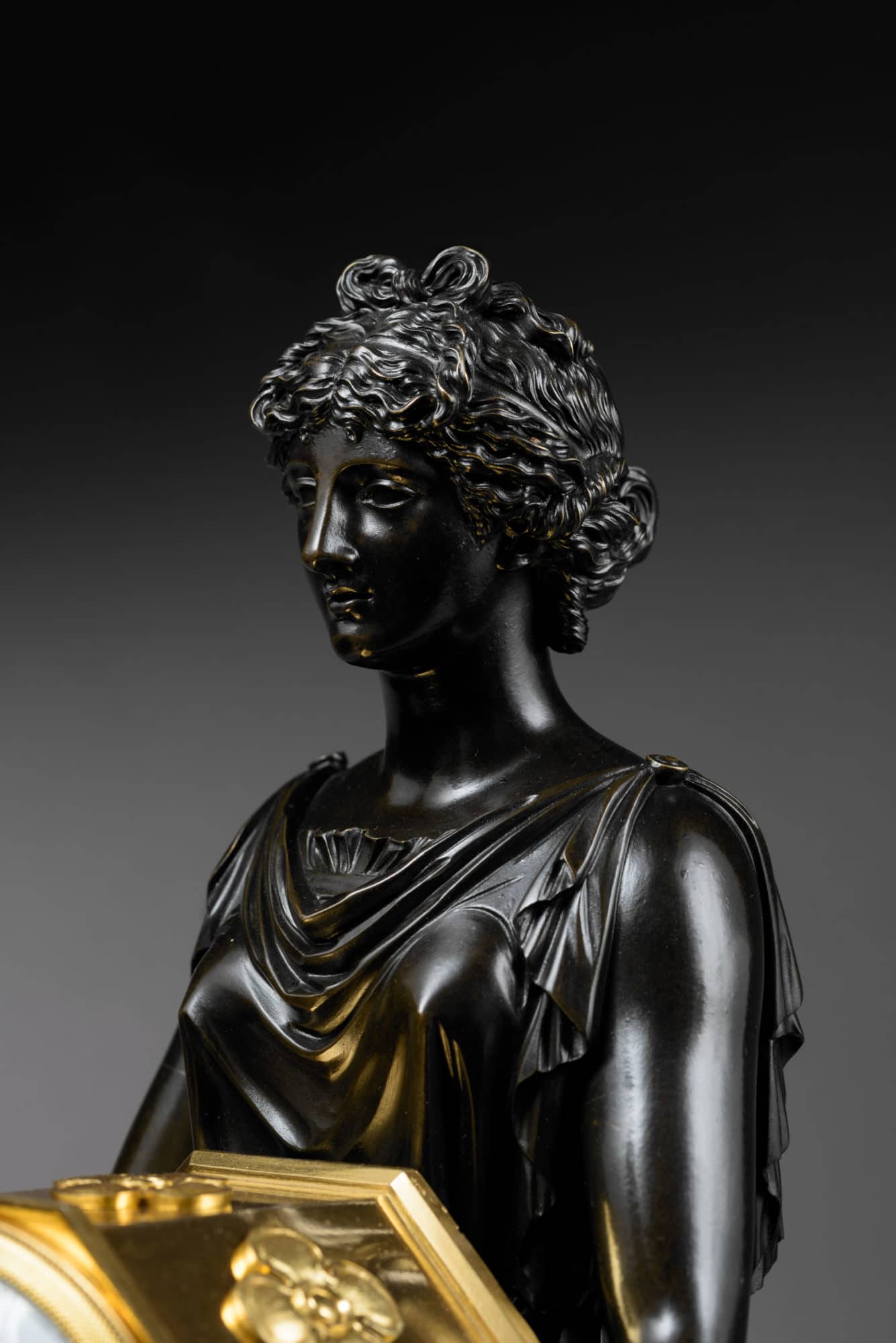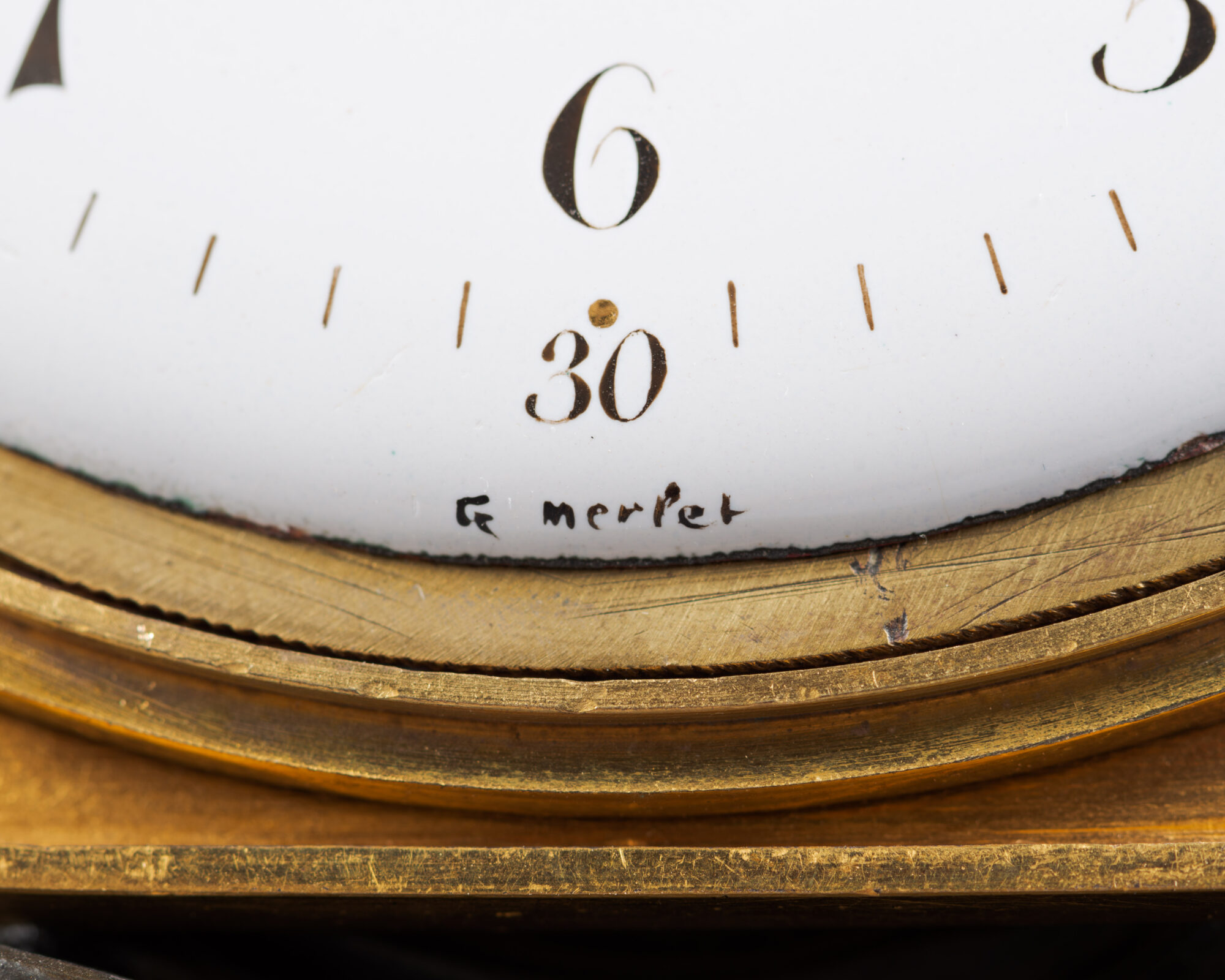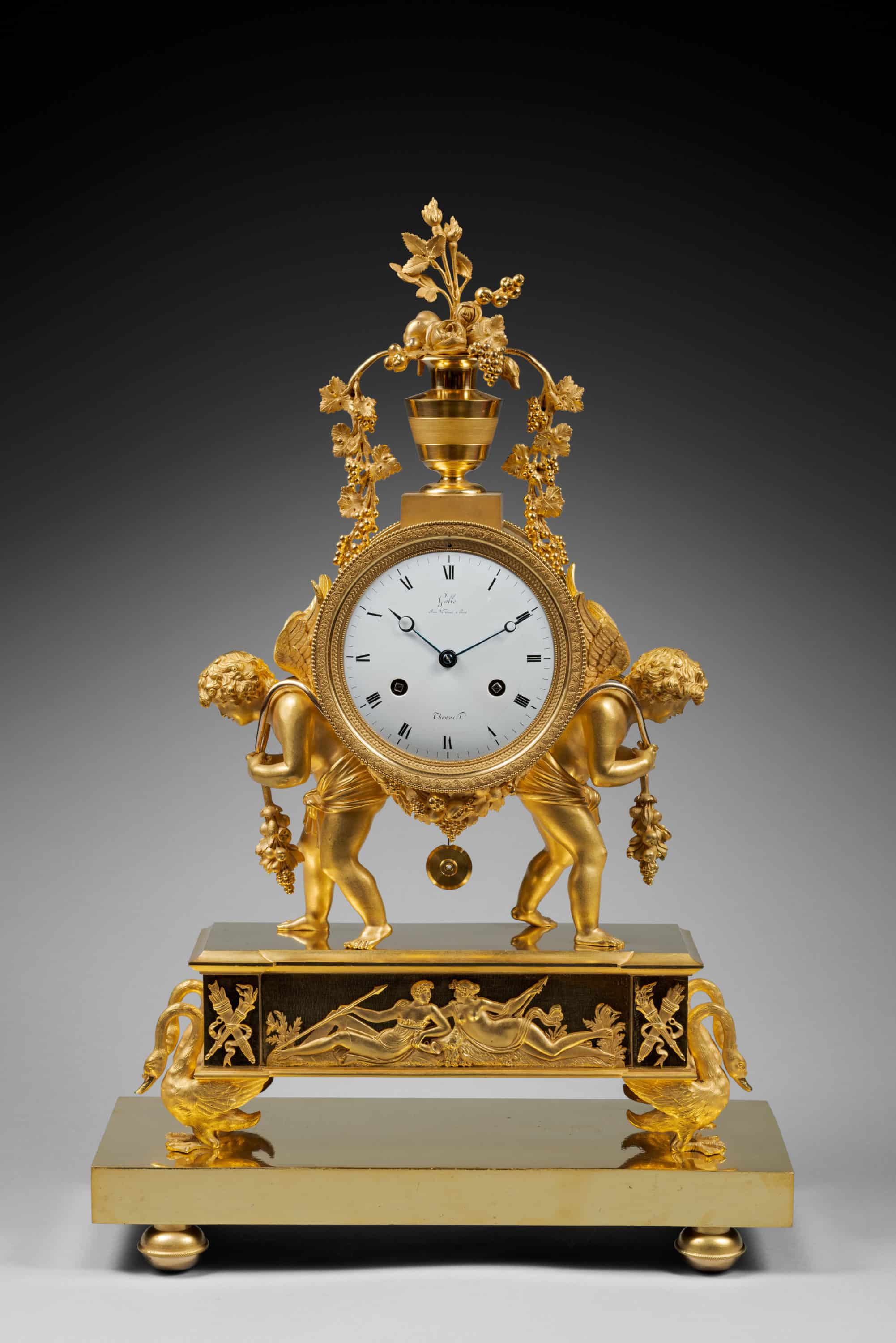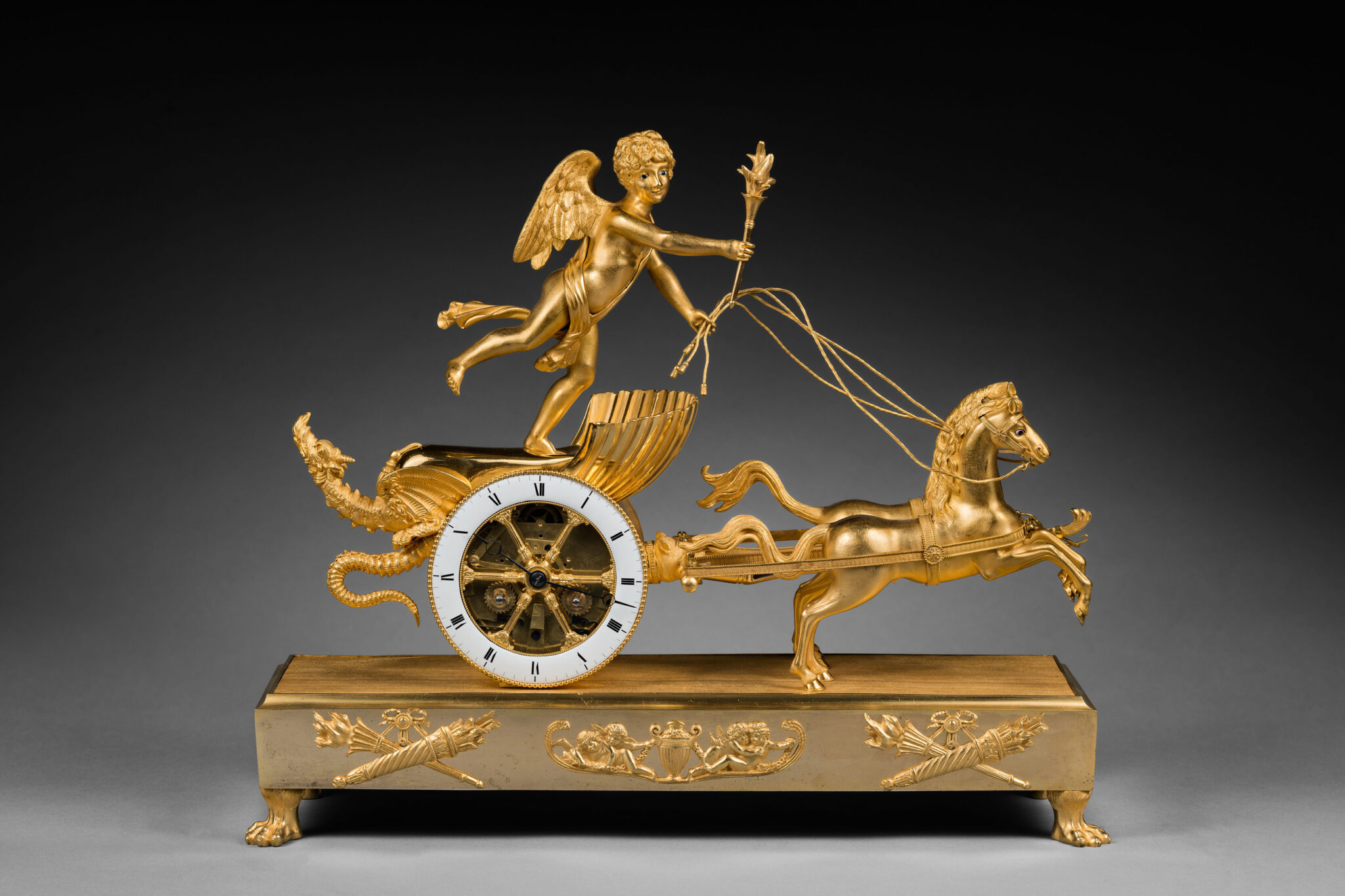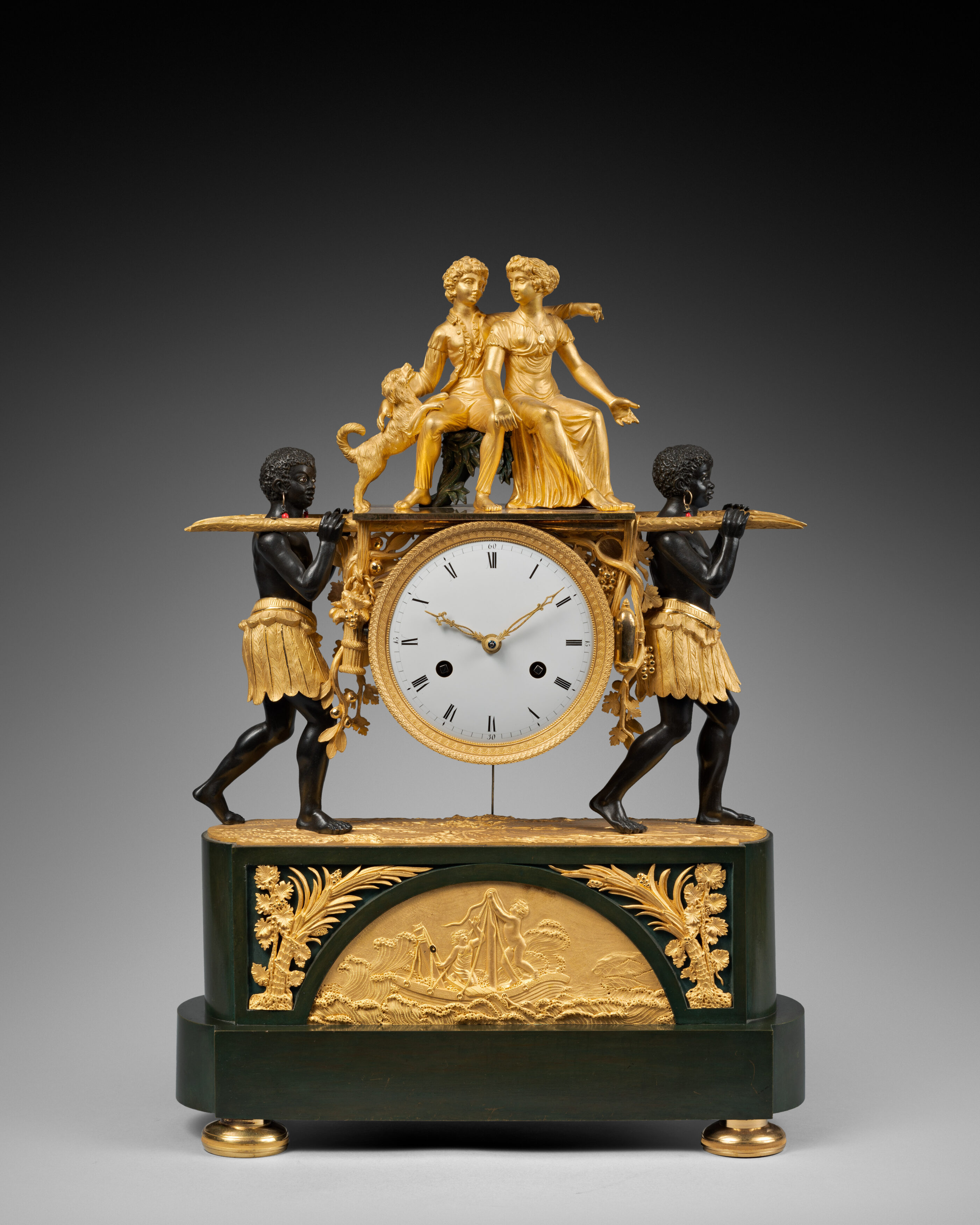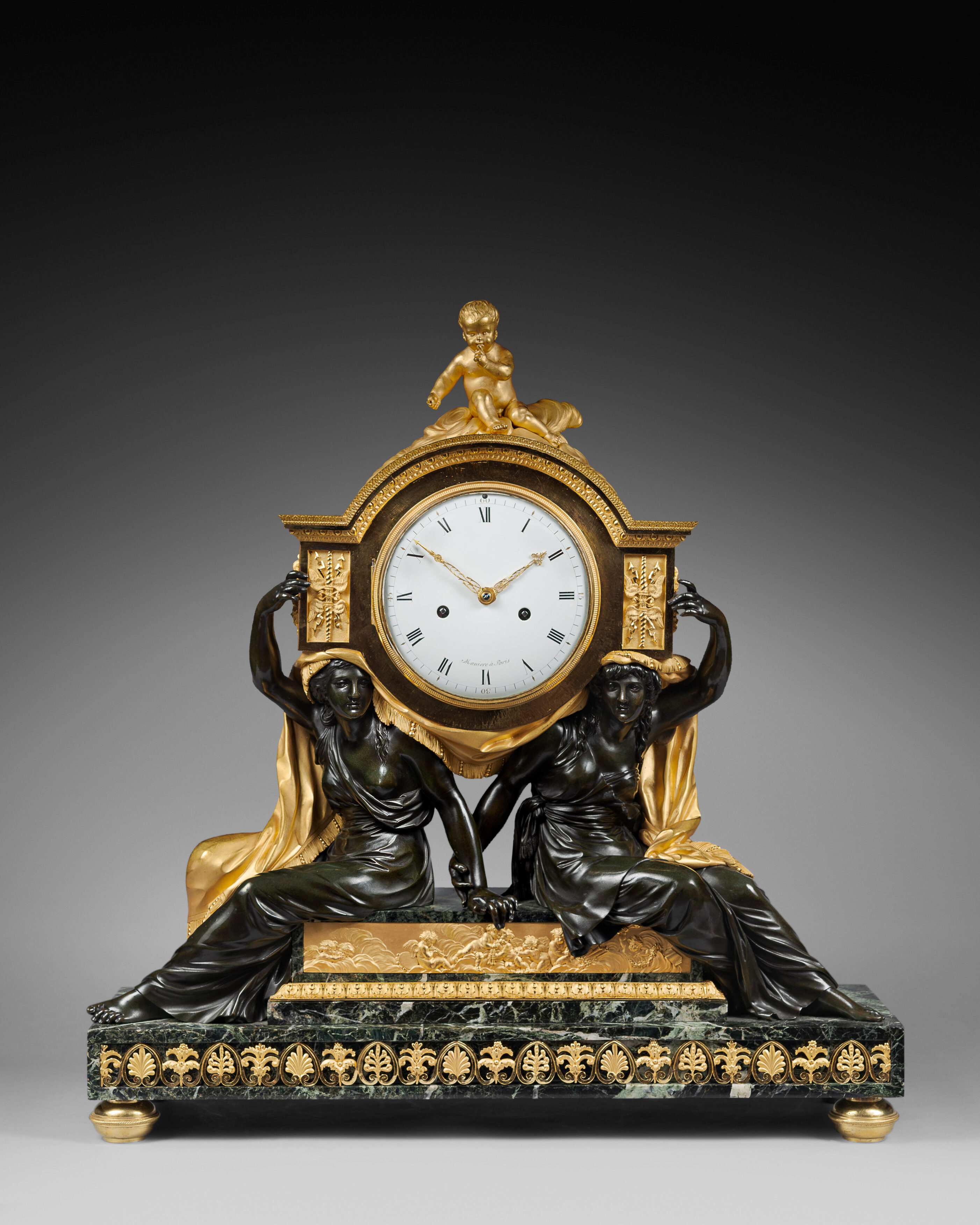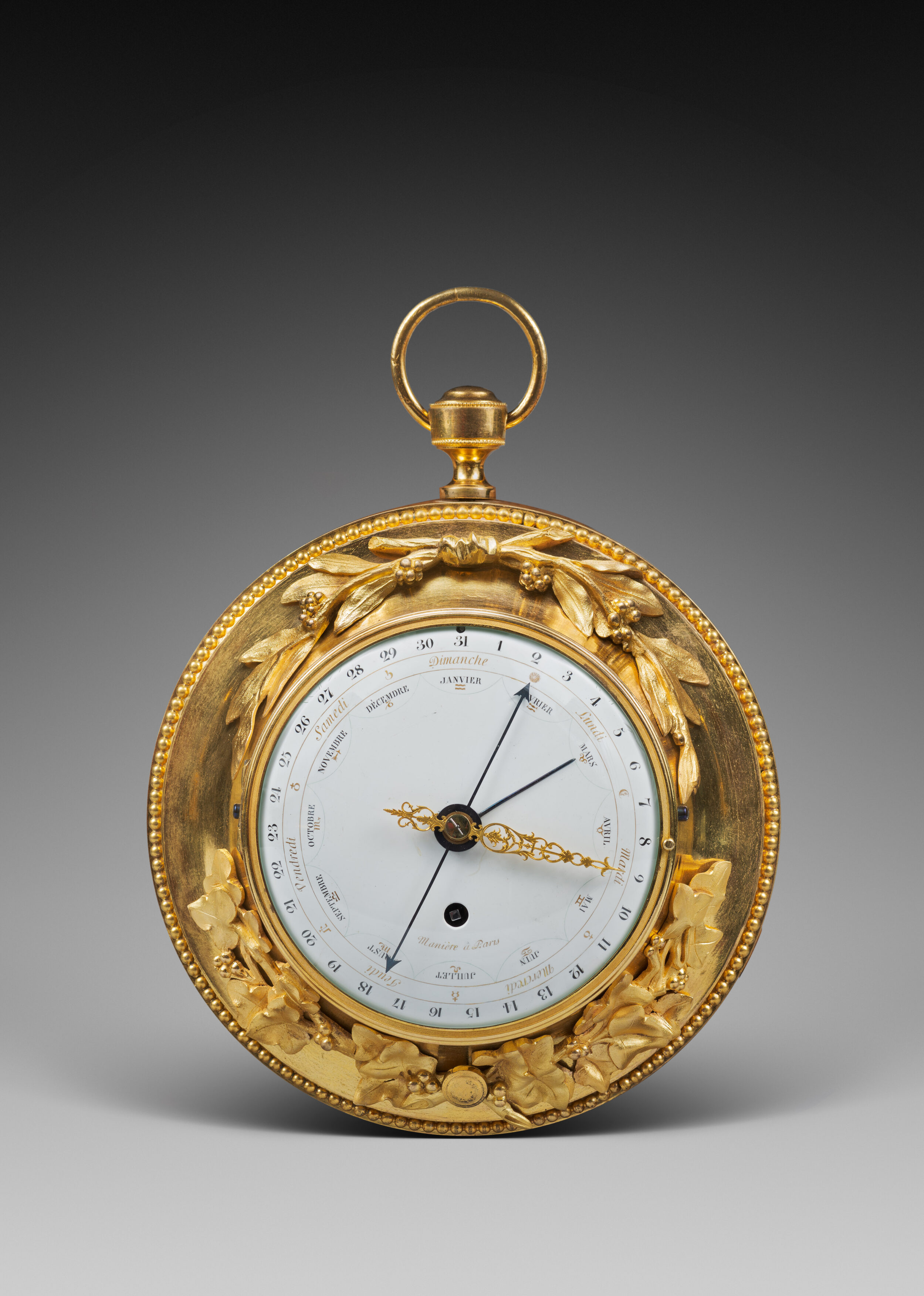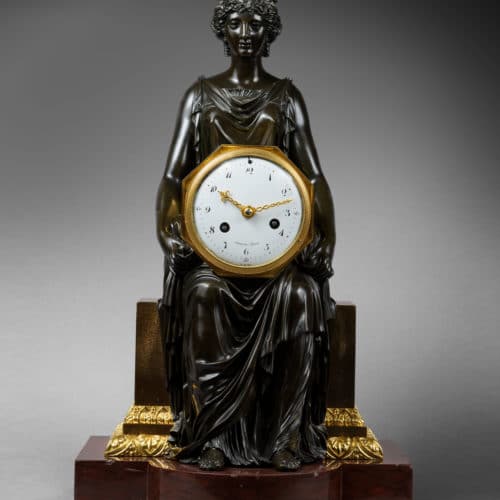Important Red Griotte Marble and Gilt and Patinated Bronze Mantel Clock with Allegorical Figure
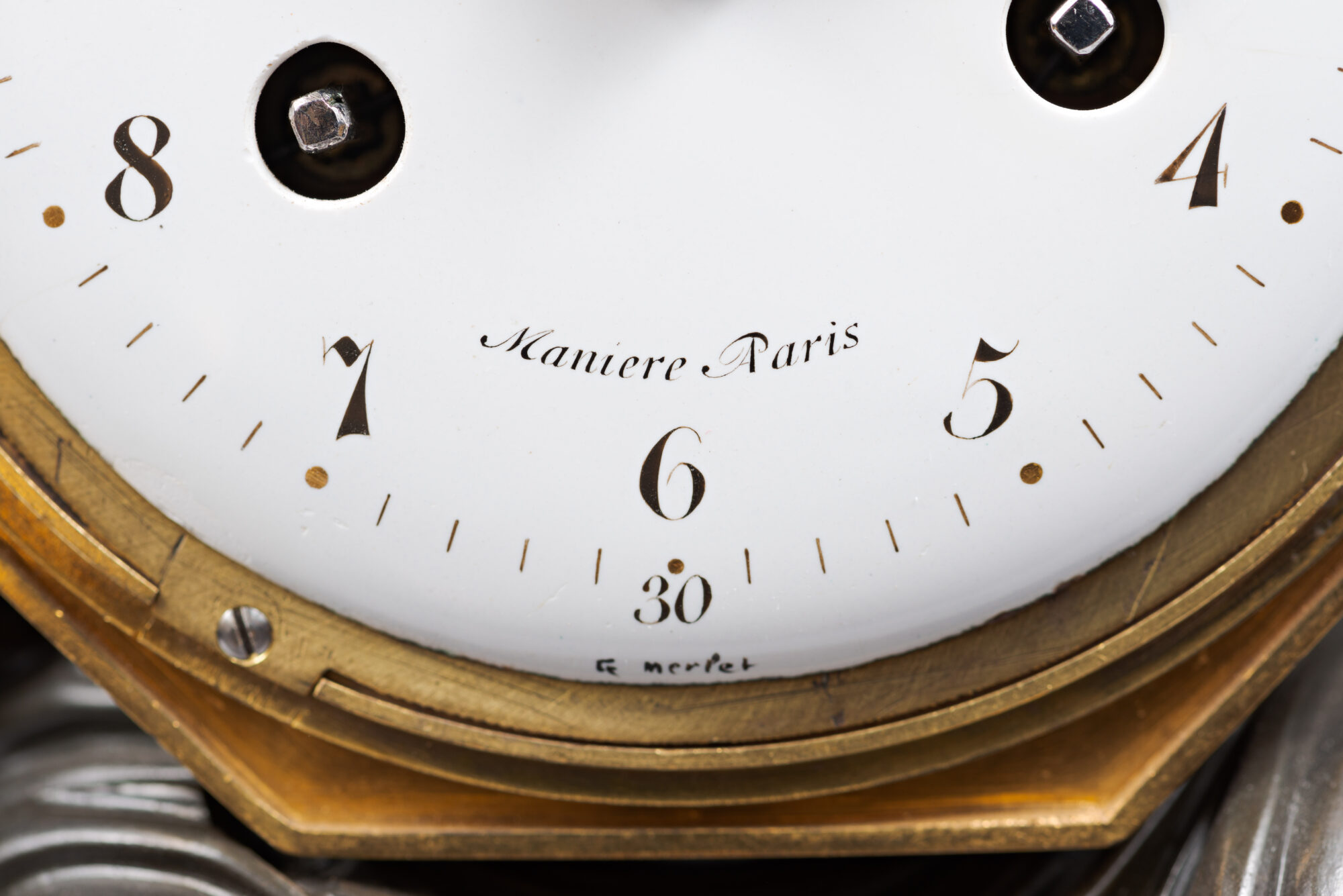
Dial signed “Manière à Paris” by the clockmaker and “G Merlet” by the enameller
Case attributed to Claude Galle
Paris, early Empire period, circa 1805
The round enamel dial, signed “Maniere à Paris”, indicates the Roman numeral hours and the outermost fifteen-minute graduations by means of two pierced gilt bronze hands. It bears the mark of Georges-Adrien Merlet, one of the best contemporary Parisian enamellers and the most important rival of Joseph Coteau and Dubuisson. The movement is housed in a hexagonal case whose engine-turned bezel is decorated with beading and whose sides are adorned with four-petalled flowers. It rests upon the knees of a woman dressed in antique draperies who is sitting on a square pillar adorned with leaf friezes. The oblong red griotte marble base has a rounded, protruding façade; it is raised upon five flattened ball feet.
Discover our entire collection of antique mantel clocks for sale online or at the gallery.
La Pendulerie is the specialist in fine and rare antique clocks, based in Paris.
The unusual design of the present clock was inspired by ancient Greek and Egyptian sculpture. The solemn seated female figure appeared in the early years of the 19th century and became quite popular, as attest the similar clocks with variations, of which a small number has survived to the present.
Among these, one clock in which the figure is holding a tablet is shown in P. Heuer and K. Maurice, European Pendulum Clocks, Decorative Instruments of Measuring Time, Munich, 1988, p. 85, fig. 150. A second, similar clock, whose dial is signed “Piolaine”, is in the Pavlovsk Palace in Saint Petersburg (see A. Kuchumov, Pavlovsk, Palace & Park, Leningrad, 1975, fig. 163). Another model, today in the Musée de la Malmaison, and which was delivered circa 1800-1803 to the Château de Saint-Cloud, appears to be the same example that was in the 1825 sale of the collection of the architect Hurtault, in which the name of the sculptor of the female figure was mentioned: “… the antique green bronze figure is by the sculptor M. Masson…” (see the exhibition catalogue La mesure du Temps dans les collections de Malmaison, May 29, 1991-15 September 1991, RMN, Paris, p. 12, catalogue n° 5). One further clock, identical to the present example, and which is thought to be an allegory of Night, is in the Museo de Relojes de las Bodegas; it has been attributed to the famous Parisian bronze caster Claude Galle (see E. Niehüser, Die Französische Bronzeuhr, Munich, 1997, fig. 468; see also L. Montanés, Catalogo ilustrado del Museo de relojes, Fundacion Andrés de Ribera, Jerez de la Frontera, 1982, p. 101; catalogue n° 171).
Charles-Guillaume Hautemanière (? - 1834)
Charles-Guillaume Hautemanière, known as Manière (mort à Paris en 1834) is one of the most important Parisian clockmakers of the late 18th and early 19th centuries, he became a Master on May 1, 1778, and opened a workshop in the rue du Four-Saint-Honoré. He immediately became famous among connoisseurs of fine horology. Throughout his career, Manière sourced his clock cases from the best Parisian bronze casters and chasers, including Pierre-Philippe Thomire, François Rémond, Edmé Roy and Claude Galle. Marchands-merciers such as Dominique Daguerre and Martin-Eloi Lignereux called upon him to make clocks for the most influential collectors of the time, including the Prince de Salm, the banker Perregaux and the financier Micault de Courbeton, all three of whom were collectors of fine and rare horological pieces. Today, his clocks are found in the most important international private and public collections, including the Hermitage Museum in Saint Petersburg, the Musée national du château de Fontainebleau, the Quirinal Palace in Rome, the Nissim de Camondo Museum in Paris and the Musée national du château de Versailles et des Trianons.
Discover our entire collection of luxury clocks for sale on La Pendulerie Paris.
Claude Galle (1759 - 1815)
One of the foremost bronziers and fondeur-ciseleurs of the late Louis XVI and Empire periods, Claude Galle was born at Villepreux near Versailles. He served his apprenticeship in Paris under the fondeur Pierre Foy, and in 1784 married Foy’s daughter. In 1786 he became a maitre-fondeur. After the death of his father-in-law in 1788, Galle took over his workshop, soon turning it into one the finest, and employing approximately 400 craftsmen. Galle moved to Quai de la Monnaie (later Quai de l’Unité), and then in 1805 to 60 Rue Vivienne.
The Garde-Meuble de la Couronne, under the direction of sculptor Jean Hauré from 1786-88, entrusted him with many commissions. Galle collaborated with many excellent artisans, including Pierre-Philippe Thomire, and furnished the majority of the furnishing bronzes for the Château de Fontainebleau during the Empire. He received many other Imperial commissions, among them light fittings, figural clock cases, and vases for the palaces of Saint-Cloud, the Trianons, the Tuileries, Compiègne, and Rambouillet. He supplied several Italian palaces, such as Monte Cavallo, Rome and Stupinigi near Turin.
In spite of his success, and due in part to his generous and lavish lifestyle, as well as to the failure of certain of his clients (such as the Prince Joseph Bonaparte) to pay what they owed, Galle often found himself in financial difficulty. Galle’s business was continued by his son after his death by his son, Gérard-Jean Galle (1788-1846). Today his work may be found in the world’s most important museums and collections, those mentioned above, as well as the Musée National du Château de Malmaison, the Musée Marmottan in Paris, the Museo de Reloges at Jerez de la Frontera, the Residenz in Munich, and the Victoria and Albert Museum in London.
Discover our entire collection of rare clocks on La Pendulerie Paris.
Georges-Adrien Merlet was one of the finest Parisian enamellers of the 18th century, a colleague and competitor of Joseph Coteau, Barbichon and Etienne Gobin, known as Dubuisson. His best-known works include clock dials and decorations, notably for skeleton clocks, which he usually signs “G Merlet” or “GM”. His clock collaborations include bronziers Jean-André Reiche and Claude Galle, and merchant Dominique Daguerre. He works with many clockmakers, including Renacle-Nicolas Sotiau, Charles-Guillaume Hautemanière, Jacques-Thomas Bréant, Lepaute, Robert Robin, Laurent Ridel, Pierre-Claude Raguet-Lépine and Nicolas-Alexandre Folin.
